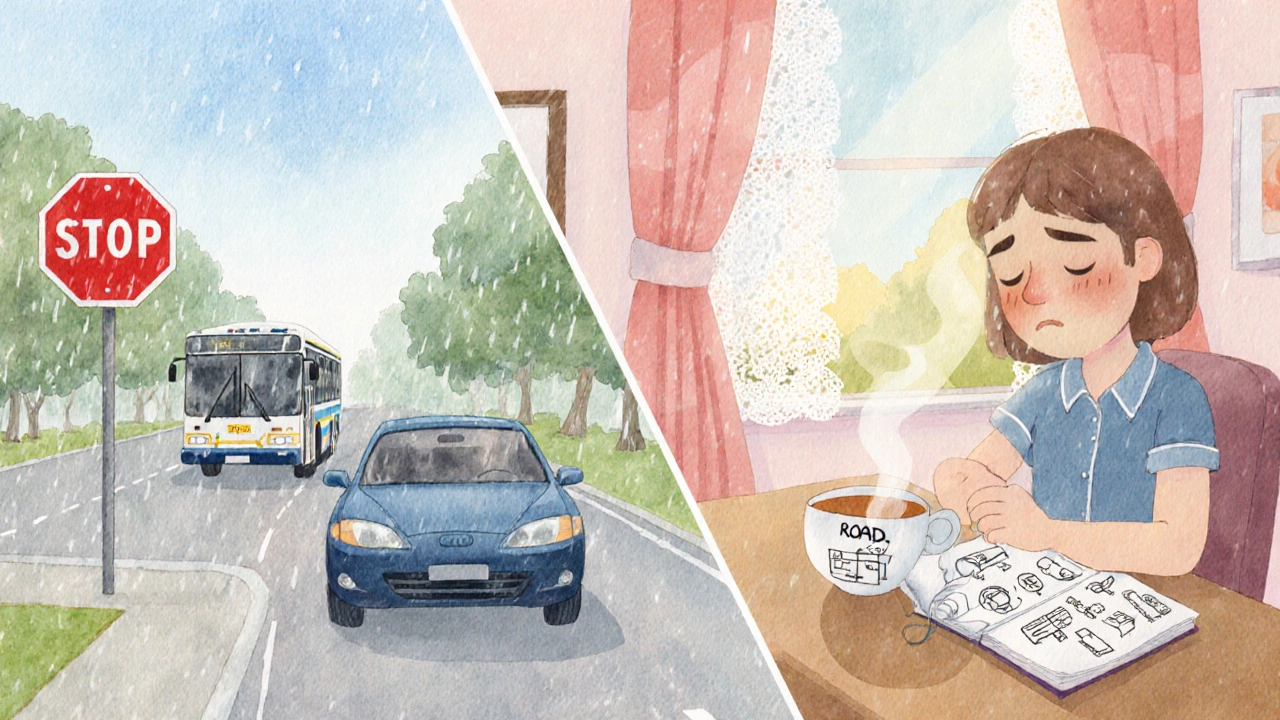Bad Driving Lesson Analyzer
Identify the root cause of a bad driving lesson and get personalized recovery tips.
Step 1: Select the main contributing factor
Step 2: Describe the situation
Analysis & Recovery Plan
Recommended Actions
Driving lesson is a structured teaching session where a licensed instructor guides a learner behind the wheel, typically lasting 45-60 minutes and covering specific manoeuvres, traffic rules, and confidence‑building exercises.
Finding yourself rattled after a bad driving lesson can feel like a personal failure, but it’s far more common than most learners admit. Below we break down why a terrible session happens, whether it’s normal, and exactly what you can do to turn the experience into a stepping stone rather than a setback.
What Makes a Lesson Feel “Bad”?
Three core entities interact during any lesson: the driving instructor a certified professional who designs and delivers the lesson plan, the learner the provisional driver trying to absorb new skills, and the vehicle the car or trainer used for practice, equipped with dual controls. When any one of these components is out of sync, the lesson can quickly feel disastrous.
- Instructor factors: low experience level, harsh feedback style, or a rushed schedule.
- Learner factors: fatigue, anxiety, or over‑confidence that blinds you to gaps.
- Vehicle factors: malfunctioning controls, unfamiliar model, or a noisy cabin that distracts.
- External factors: heavy traffic, bad weather, or a confusing road layout.
These variables intersect with the lesson plan a pre‑approved set of objectives for the session. If the plan assumes ideal conditions and they’re not met, the mismatch can feel like a personal blow.
Is It Normal? The Data Behind the Feeling
According to the New Zealand Transport Agency’s 2023 learner‑driver survey, 42% of provisional drivers reported at least one lesson they described as “terrible” or “demotivating”. Of those, 68% said the experience was linked to a single factor-most often the instructor’s communication style.
This statistic shows that a bad lesson isn’t a rare anomaly; it’s a statistically significant portion of the learning journey. The key is recognizing that the incident is a data point, not a verdict on your future driving ability.
How to Diagnose the Root Cause
After the lesson, take five minutes to journal the experience. Capture the following entities:
- Instructor behaviour tone, pacing, and feedback frequency
- Learner state energy level, stress, and focus
- Vehicle condition any mechanical quirks or unfamiliar controls
- External environment traffic density, weather, and road signage
Identify which item felt most out of sync. If you pinpoint the instructor’s tone as the primary driver, you’ll address it differently than if the vehicle’s clutch felt sticky.
Recovering Confidence After a Rough Session
The fastest way to rebuild confidence is to separate the incident from your overall skill trajectory. Treat the lesson as a case study rather than a judgment.
- Re‑watch video: Many schools now offer dash‑cam footage. Watching yourself can clarify whether the issue was perception or execution.
- Micro‑practice: Schedule a 15‑minute solo drive in a low‑traffic parking lot to rehearse the specific manoeuvre that tripped you up.
- Positive reinforcement: Write down three things you performed well, even if they seem small (e.g., smooth gear changes).
These steps create a feedback loop that counteracts the negative emotions generated by the bad lesson.

Communicating With Your Instructor
Open dialogue is the bridge between a poor experience and a productive one. Use the following script, which references the key entities you documented:
“Hi [Instructor Name], I felt the last lesson was tougher than expected, especially around [specific manoeuvre]. I think my confidence dropped because I was [state your feeling]. Could we slow down on that part next time and maybe try a different teaching approach?”
Framing the conversation around concrete observations (vehicle handling, lesson plan gaps) keeps it professional and solution‑oriented.
When to Switch Instructors or Schools
If you’ve raised concerns three times and the situation hasn’t improved, it may be time to evaluate alternatives. Consider these criteria, presented in a comparison table:
| Attribute | Good Lesson | Bad Lesson |
|---|---|---|
| Instructor experience | 5+ years, calm feedback | ≤2 years, abrupt criticism |
| Lesson pacing | Adapted to learner’s pace | Rushed, many new tasks |
| Feedback clarity | Specific, actionable | Vague, overwhelming |
| Vehicle condition | Well‑maintained, familiar model | Sticky clutch, unfamiliar controls |
| Learner confidence | Growing, positive self‑talk | Plummeting, self‑doubt |
If the pattern aligns more with the “Bad Lesson” column across multiple sessions, a change of instructor or school is a reasonable next step.
Tips for Your Next Lesson
Prepare a mini‑brief for yourself and your instructor. Include these entities:
- Goal e.g., master parallel parking without stalling
- Focus area specific skill you want feedback on
- Success metric how you’ll know you succeeded (e.g., park within 30cm of curb)
By setting clear, measurable objectives, you give the instructor a roadmap that reduces ambiguity and promotes constructive feedback.
Related Concepts Worth Exploring
If you’re curious about the broader learning ecosystem, consider digging into these adjacent topics:
- Defensive driving techniques that anticipate hazards and reduce accident risk
- Learning anxiety psychological response that can impair performance behind the wheel
- Pass Plus course advanced post‑licence training focusing on complex traffic situations
- Provisional licence regulations legal limits on speed, passengers, and night driving for new drivers
Each of these entities connects back to the core lesson experience, enriching your overall driver education journey.
Key Takeaways
A truly bad driving lesson is a normal data point in the learning curve. By dissecting the interaction of instructor, learner, vehicle, and environment, you can pinpoint the cause, communicate effectively, and implement concrete steps to bounce back. If patterns persist, trust the comparison table and consider switching to a better‑aligned instructor or school.

Frequently Asked Questions
Why do some driving lessons feel worse than others?
Lesson quality hinges on the match between instructor style, learner readiness, vehicle familiarity, and external conditions. When any of these entities clash, the experience can feel unusually harsh.
Is it okay to ask for a different instructor after a bad lesson?
Absolutely. Your confidence matters more than loyalty to a single instructor. Most schools permit a switch after a reasonable number of sessions if constructive feedback hasn’t improved the situation.
How can I tell if my anxiety is affecting my lesson performance?
Common signs include sweaty hands, racing thoughts, and hesitating before simple actions. If you notice these alongside a bad lesson, consider a brief mindfulness exercise before the next session.
What should I do if the training vehicle feels unsafe?
Report the issue to the school immediately. A well‑maintained vehicle is a core safety requirement, and schools are obligated to provide a functional car for each lesson.
Can a single bad lesson delay my licence test?
Not usually. Test readiness is measured over multiple sessions. One rough lesson won’t cancel your booking, but it might highlight skills you need to rehearse before the official test.

